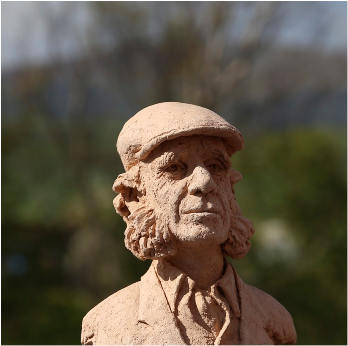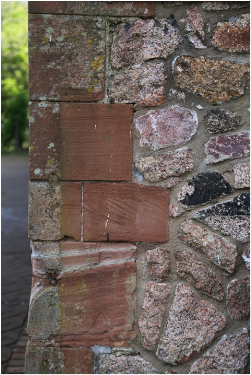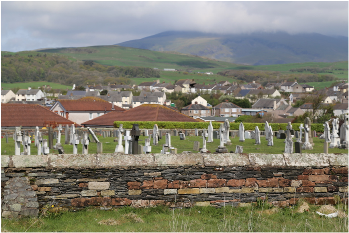 The year 2014 has many notable anniversaries. One that might pass by outside Cumbria is the centenary of the birth of the poet and writer Norman Nicholson, writes Brian Whalley.
The year 2014 has many notable anniversaries. One that might pass by outside Cumbria is the centenary of the birth of the poet and writer Norman Nicholson, writes Brian Whalley.
He is the subject of Kathleen Jones’ The Wispering Poet and David Boyd’s, Norman Nicholson: A Literary Life and I defer the biography and literary analysis to them. However, a note about Nicholson’s appreciation of geology might not go amiss to readers of Geoscientist.
From Millom Rock Park (www.millomrockpark.org.uk), tucked away off the A 5093 (down the side road to School Ellis) you can see the town of Millom, where Norman Nicholson spent almost all his life.
Norman Cornthwaite Nicholson was born at 14 St George’s Terrace Millom on 8th January 2014 and resided there for all but two years of his life. ‘The Whispering Poet’ not only provides a readable biography but refers to the two years that Nicholson spent in a sanatorium in Hampshire as a sufferer of TB. He was allowed to whisper, but not talk, for fear of damaging his voice. He returned to Millom and from then on the town and its surrounding area were to figure in his poetry and writing. It was probably during his convalescence that his reading provided him with a grounding in geology and botany. As a walker in the nearby fells he built a love and understanding of local geology, scenery and history. As Kathleen Jones (Chapter 10, location 1940) has put it:
Norman revealed a passion for the geology of the Lake District. ‘In no other part of England,’ he wrote, ‘has the life and character of a district and its people been so controlled by the nature of the rock and by the forces which acted upon it’. He went even further; ‘ to look at the scenery of Cumberland and Westmorland without trying to understand the rock is like listening to poetry in an unknown language – you hear the beauty of the sounds, but you miss the meaning. For the meaning is the rock.’
This geological understanding, which is much more than appreciation, comes though in many of his poems. In The Pot Geranium (1954) there is a sequence of poems, ‘The Seven Rocks’. You only have to have a mental image of the geological map of Cumbria to appreciate these: Skiddaw Slate, Scafell Ash, Coniston Flag, Eskdale Granite, Mountain Limestone, Maryport Coal and St Bees Sandstone. These are not just names for poems but an incorporation of the geology:
Here the river of time in a delta spread
The bulged and buckled mud that leaves us firm
As faith above the misty minutes
(from Skiddaw Slate)
Therefore hope
is a theological virtue
And a geological grace,
Felt in the why
And wherefore of a rose,
And when rocks solidify
And the watching sky
Knows the fire’s purpose
And the way the water flows’.
(from Scafell Ash)
 Picture: Millom Railway station buildings
Picture: Millom Railway station buildings
Nicholson also understands geomorphological processes; especial in Beck, Dunes and Shingle. And the metaphors in The Council of the Seven Deadly Sins (Five Rivers, 1944):
Inside the school where sea winds rumble
The parish councilors assemble.
The Chairman at the teacher’s table
Rubs his jaw like a smooth cobble.
His chin is granite, eyes are flint
That on his rusted colleagues glint
suggest an activity for your next committee meeting…..
If you visit Millom from the south and take a geological trip to the Lakeland Peninsulas from the M6 you will by-pass Grange-over-Sands (where limestone ‘goes on the razzle’). Or, from the north, pass-by Cleator Moor where, once,
The miner at the rockface stands,
With his segged and bleeding hands
Heaps on his head the fiery coal,
And feels the iron in his soul’.
(Cleator Moor, Five Rivers, 1944)
The Millom Museum (at the station) not only is built from some of ‘The Seven Rocks’ but has a room devoted to mining at Hodbarrow with some good samples from the mines and locality. For it is at Hodbarrow (54 12’04”N 3 16’20”W), a kilometer from Millom, that the ‘sea walls’ provide interest for the groundwater hydrologist and mining engineer alike where the rich hematite was mined and moved to the blast furnaces (Harris 1970). These are long pulled down but the social consequences are recorded in several of Nicholson’s poems.
At Hodbarrow the mining of the 19th-20th century becomes personal:
At seventy fathom
My Uncle Jack was killed
With half a ton of haematite spilled on his back.
They wound him up to the light
Still gasping for air.
(Hodbarrow Flooded, A Local Habitation, 1972)
Working geology is also part of the scene. For example, The Borehole (A Local Habitation, 1972)
Five hundred feet of limestone shudders and
Creaks down all its strata’d spine of ammonites and shells.
There are references to haematite (sic) in many of the poems but even more unusually;
Cañons in granophyre and shale.
As the old miners wrought with feather, stope
And mallet ……...
(Silecroft Shore, Rock Face, 1948)
 Picture: Wall around the graveyard in which Nicholson lies buried, with Black Combe in the distance
Picture: Wall around the graveyard in which Nicholson lies buried, with Black Combe in the distance
With Nicholson, it is not just a matter of using words, especially geological or mining terms, as something that seem to fit and create a geological allusion (or illusion) but he knows what they mean, and how to use them geologically.
Nicholson’s topographic essays are often distinctly geologically aligned, as can be seen from the quotation from Kathleen Jones’ book above. Thus,
‘So far, the limestone may have seemed to be more of a neighbour to the Lakes than a part of them. But in some of the valleys which run down to Morecambe Bay it walks right in amongst the hills of the slate. '
(Portrait of the Lakes, p 43)
The slate referred to is from the Silurian Kirkby Moor grits (where the Burlington Slate quarry lies tucked away off the A 5902). The limestone sliver described above ends at the sea at Millom on the Duddon Estuary. In the limestone, rich hematite ore was discovered, mined and smelted between 1855 and 1968. In ‘Local Habitation’, Nicholson’s book of poems of 1972, he describes the area, including On the closing of Millom Ironworks. The volume also contains Scree:
Shedding the paleozoic years like bark,
While habitual, dark
Roots hankered back to unfossiliferous blocks
of rocks that made the rocks.
Nor is it only rocks, scenery and industrial archaeology. Nicholson knows his geological history. In The Lakers he mentions Jonathan Otley who, he reminds us (p. 160), ‘led Professor Sedgwick to the Lake rocks’.
Nicholson is also conversant with botany, having poems about The Bloody Cranesbill, and Weeds amongst others. These are not just poems about plants but include the grittiness of the slagheaps and where ‘limestone met the tide’ as well as the personal element; ‘A town’s purpose subsides with the mine’. There is a knowledge of astronomy too as can be seen in the poem Halley’s Comet:
Its thirty-seven-million-mile-long kite
Across Black Combe’s black sky.
And, in Comet Come (1986),
Anxious astronomers protest:
Give them a month, they’ll know just what
The frozen core is made of, test
The fluorescence tailing from it,
Fanned out in the solar wind,
The inlier of Black Combe behind Millom figures in many of his poems, directly or indirectly. And the townscape it dominates has more than traces of geology in it, as described in Millom Old Quarry (The Pot Geranium, 1954):
But Market Street’s
Brown freestone,’ I said
… but they’re Cumberland slate at the back
Alan Smith’s Lakeland Rocks, uses quotations from a variety of Nicholson sources to further illustrate his introductory guide. As I hinted, the composite poem, The Seven Rocks brings geology directly to poetry, including as it does, Coniston Flag. You will not find a detailed discussion of the Windermere Supergroup, but nevertheless;
In dormer, porch and gable-ends,
Chimney and windowsill, it blends
Silt of a fossil-time of tides.
Blue stone in every cleavage hides.
Despite being published by T.S. Eliot at Faber, Nicholson’s reputation is not nowadays part of mainstream poetry. Yet, in Between Comets, Seamus Heaney, George McKay Brown and R.S. Thomas, amongst other notable poets, wrote tribute poems and he was awarded the Queen’s Gold Medal for Poetry. So, in his centenary year, Nicholson is probably ready for renewed exploration. Nicholson’s west Cumbria is well worth a visit, in person or by way of his writings. You will find more than geology and botany and an appreciation of scenery in his works but also his views on the dangers of nuclear power and environmental destruction, and in his verse plays, Prophesy to the Wind and The Old Man of the Mountains.
I hope I have whetted your appetite for reading Nicholson as nights close in – whether biography, travel or, especially, his poetry. Poetry is in the head of the reader and in Norman Nicholson’s you should find much of interest about the character of Cumbria; present, past and deep-past.
Brian Whalley
References and a short bibliography
- Boyd, D. 2014. Norman Nicholson: A Literary Life, Seascale Press
-
Harris, A. 1970. Cumberland Iron. D. Bradford Barton, Truro.
-
Hunt I. (ed) 1991. Norman Nicholson’s Lakeland, A Prose Anthology. Robert Hale London.
-
Jones, K. 2013. Norman Nicholson: The Whispering Poet. The Book Mill.
-
Nicholson, N. 1946. The Old Man of the Mountains. Faber and Faber, London.
-
Nicholson, N. 1950. Prophesy to the Wind. Faber and Faber, London.
-
Nicholson, N 1955 The Lakers. Robert Hale, London (also, 1995, Cicerone Press, Milnthorpe)
-
Nicholson, N. 1959. Provincial Pleasures, Bookcase, Carlisle.
-
Nicholson, N. 1963. Portrait of the Lakes. Robert Hale, London.
-
Nicholson, N. 1969. Greater Lakeland. Robert Hale, London.
-
Nicholson, N. 1994. Collected Poems. (ed) N. Curry, Faber and Faber, London.
-
Scammell, W. (ed) 1984. Between Comets; for Norman Nicholson at 70. Taxus Press, Durham.
-
Smith, A. 2010. Lakeland Rocks. Rigg Side Publications. Keswick.
Illustrations:
Maquette of Norman Nicholson by Joan Palmer, courtesy of Peggy Troll (dedicatee of Comet Come, with Black Combe in the distance.
Millom Railway station buildings
Wall around the graveyard in which Nicholson lies buried, with Black Combe in the distance.